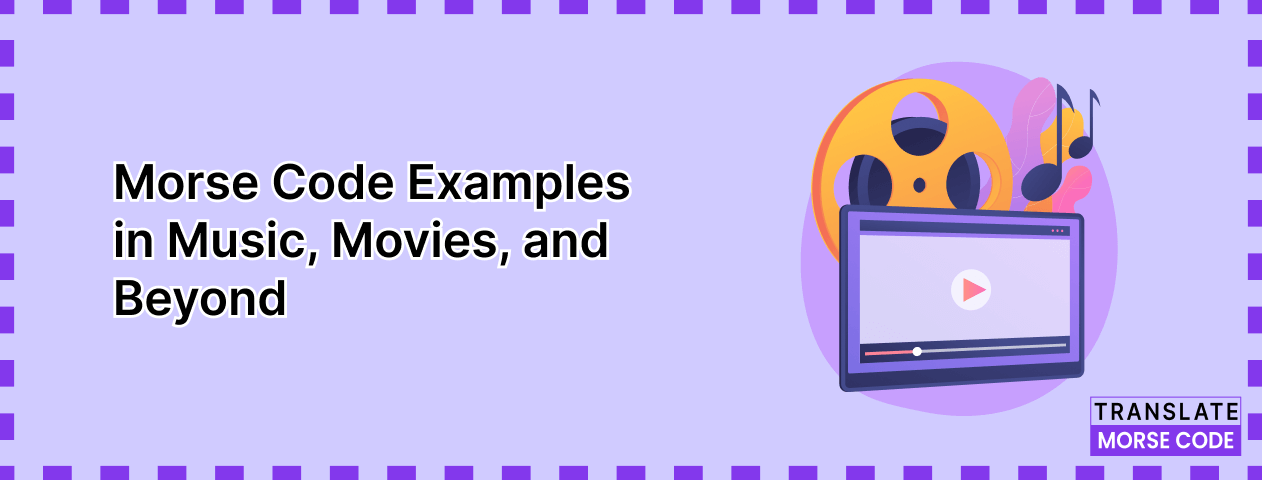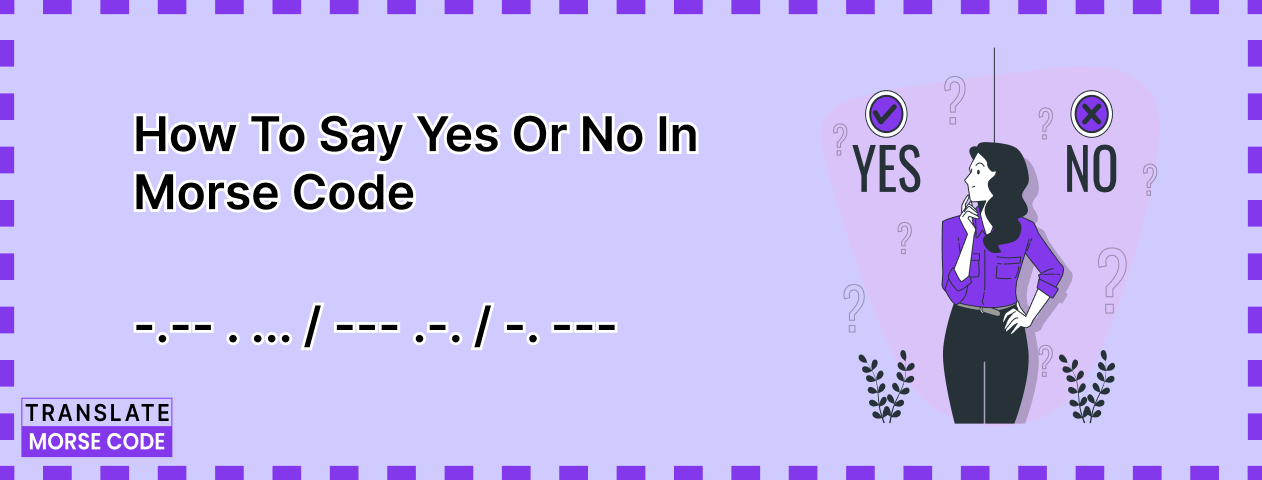From Dots and Dashes to Blockbusters: Morse Code Examples in Music, Movies, and Beyond

Samuel Morse and Alfred Vail created the Morse Code in the 1830s for telegraphy. Now, it has moved beyond its practical beginnings to leave a lasting mark on pop culture. Morse code has woven into cultural aspects beyond its role in communication technology. Its influence is far-reaching, from hidden musical notes to suspenseful cinematic sequences.
This article explores the surprising and enduring impact of Morse Code in realms such as music, movies, fashion, and technology. It shows how this language of dots and dashes has become a symbol of historical importance.
Morse Code in Music
Morse Code's rhythmic simplicity and patterns have found a unique musical resonance. It creates a captivating fusion of technology and melody.
Musicians and composers used Morse Code in their music, giving it extra meaning and mystery. It adds a unique layer of symbolism and intrigue to their works.
RUSH - "YYZ"
In Rush's instrumental track "YYZ," the opening riff cleverly incorporates Morse code. He spells out the airport code for Toronto Pearson International Airport—YYZ.
Guitarist Alex Lifeson, who was training as a pilot. He experienced the Morse code for YYZ during a flight to Pearson Airport.
The band found it intriguing and integrated the Morse code rhythm into the song. Morse code gives it a distinctive and meaningful element.
ABBA - "S.O.S"
ABBA takes a literal approach in "S.O.S.". The Morse code in the song is a straightforward representation of the distress signal "S.O.S". It was in the form of dots and dashes.
This adds a subtle layer of meaning to the music, aligning with its theme of seeking help and support in emotional distress.
The Clash - “London Calling”
In 1979, punk rock struggled while disco thrived. The Clash, a punk band, stood out. They released a song, "London Calling," in 1977.
In the song Mick Jones, using his guitar, sends an SOS message in Morse code at the end. SOS means help, like a signal for danger.
This fits the song's theme of disaster and the end of the world. The Clash used music to express strong feelings about tough times, keeping punk alive.
Kraftwerk – “Radioactivity”
Kraftwerks hit single "Radioactivity" was released in 1975 and topped the charts in France.
It features Morse code twice, spelling out the song title. In the second Morse code segment, the lyrics say, "is in the air for you and me."
This creative use of Morse code adds a unique touch to the song, emphasizing its theme of radioactivity and its presence in the environment.
Five Americans - "Western Union"
Western Union," released by a group of musicians, “Five Americans,” in 1967, features Morse code elements. That is best experienced when the song is repeated.
The Morse code in this song contributes to its unique and catchy musical arrangement. It offers a distinctive characteristic that sets it apart from other tracks.
Cabaret Voltaire - "CODE"
Cabaret Voltaire's "CODE" takes the Morse code theme to a new level. Morse code elements enhance the song's enigmatic and experimental nature.
The incorporation of Morse code aligns with the band's innovative approach to music.
Metallica - "One"
In Metallicas "One," the debate surrounds whether Morse code is used in the song.
This song tells a sad tale about a man hurt in a war. He loses his arms and legs and ends up in a hospital.
The man can't speak, but his body twitches, and he spells "S.O.S." It's like he's asking for help.
He also repeats, "Kill me," showing how much he is suffering. The song paints a picture of the pain and despair of war.
Duran Duran "The Union of the Snake"
Duran Duran's 1983 synth-pop hit, "The Union of the Snake," delves into mystery with Simon Le Bon's enigmatic lyrics.
A visually spectacular music video complements its atmospheric sound. The track, featuring a Morse Code SOS played on high-pitched keyboards around three minutes and ten seconds in. It adds another layer of intrigue.
A commercial success, the song is a timeless symbol of Duran Durans 80s pop prowess. It resonates with its catchy melodies and hidden signals.
Morse Code in Movies
Morse code is frequently used in movies for a variety of purposes, adding depth and intrigue to the storytelling. Here are a few examples:
"North by Northwest" (1959):
In Alfred Hitchcock's classic thriller, "North by Northwest," Morse code is employed during a pivotal scene. Cary Grant's character, the protagonist, is trapped in a precarious situation.
The suspense builds as Morse code signals play a crucial role in character communication. It heightened the tension and advanced the plot.
"The Martian" (2015):
In the science fiction film "The Martian," directed by Ridley Scott, Morse code is used as a vital means of communication.
Stranded astronaut Mark Watney, played by Matt Damon, uses Morse code to convey messages to Earth.
He demonstrates the code's practical application in dire situations.
This adds a realistic and suspenseful element to the character's struggle for survival.
“Interstellar” (2014)
In the epic movie "Interstellar," Morse Code becomes a secret language connecting characters.
In a powerful scene, Murph deciphers messages hidden in falling books using Morse Code. Her notebook showcases drawings of where the books vanished and Morse signals spelling "stay."
Even Hanz Zimmer, the composer, sneaks Morse Code into the soundtrack.
In the song "Coward," Zimmer cleverly transforms the ticking clock's rhythm into Morse Code, revealing the same word: "stay."
These Morse Code moments weave a hidden connection thread throughout the film's intricate narrative, adding an extra layer of meaning for attentive viewers.
"Cast Away" (2000):
Tom Hanks' character finds himself stranded on a desolate island in this Robert Zemeckis survival drama.
He uses a flashlight to signal for help.
The character blinks the light in a pattern resembling Morse code.
This emphasized the universal nature of Morse code as a communication tool, even in the absence of spoken language.
"Parasite" (2019)
This movie unveils a unique plot twist.
In the movie, the housekeeper for the wealthy Park family secretly harbors her husband in a hidden basement beneath the house.
When a sneaky family tries to get jobs in the house by tricking others, the housekeeper, afraid of being found out. He asks her husband to keep hiding.
After being isolated for a long time, the husband uses Morse code to express his gratitude to Mrs. Park.
He sends a message by using a light switch. It revealed the hidden complexities within the seemingly perfect Park household.
"Pirates of the Caribbean: Dead Man's Chest" (2006):
The popular adventure film incorporates Morse code humorously.
Captain Jack Sparrow, played by Johnny Depp, communicates through a series of eye blinks. It was similar to Morse Code.
This playful use adds a comedic touch to the character. It showcases Morse code as a creative element in character development.
"Independence Day" (1996):
"Independence Day is a science fiction hit. In this movie, Morse code plays a crucial role in Earth's defense against invading aliens.
The code coordinates a global counterattack. It demonstrates Morse code adaptability in modern contexts, even in the threats.
"Titanic" (1997)
Titanic movie was directed by James Cameron in 1997. In this movie, they use Morse code to send a distress signal as the ship is sinking.
In one of the crucial scenes, the wireless operators on the Titanic use Morse code to signal for help. The film's historical accuracy is enhanced by the use of Morse code. Additionally, Morse code adds a dramatic element to the film.
It shows how Morse code enhances cinematic narratives with suspense and character dynamics. Its versatility allows filmmakers to integrate it into various genres creatively. Morse code has had a lasting impact on the film industry and continues to be showcased on the silver screen.
Morse Code in Amateur Radio
Amateur radio operators, or "hams," have a rich tradition of using Morse Code in their communications. Historically crucial in amateur radio, Morse Code served as the primary mode for early communication. Many countries no longer require Morse Code skills for licensing.
Despite technological advancements, the Continuous Wave (CW) mode remains popular. It is especially favored in contests and special events, showcasing its enduring significance.
Morse Code is a popular choice for QRP operations. This is due to its efficiency, enabling long-distance communication with minimal power. In emergencies, Morse Code proves valuable for clear and reliable transmission.
Introducing digital modes and Morse Code decoders improves accessibility for amateur radio operators. Ongoing practice sessions and training resources support skill development.
This mode of communication has been a staple in amateur radio for many decades, and real-life examples abound. Here are some instances where Morse Code is actively used in amateur radio:
2 Best Examples of Morse Code in Amateur Radio:
- In the movie "Frequency," a detective uses his Heathkit radio to talk to his deceased father through ham radio.
Using the W2QYV call sign of the Niagara Falls, NY Radio Club, the father heeds his son's warning about a fire. It changed the history in a Ray Bradbury-like twist.
The ARRL served as a technical consultant.
- In the disaster film "Greenland," survivors communicate through ham radio after a comet destroys much of the world. The messages were like "CQ CQ CQ.
This is Greenland Station. Is anyone receiving?" shows how ham radio connects people in emergencies. In the movies, just like in real life, ham radio saves the day.
These examples illustrate the diverse ways Morse Code plays a vital role in amateur radio. It is used for contests, emergency communication, or as a personal preference. Morse Code remains a dynamic and enduring aspect of the amateur radio experience.
For a deeper understanding of Morse code, check out our comprehensive Morse Code guide.
Conclusion
Morse Code's influence extends far beyond its telegraphic origins. It has an indelible mark on the diverse tapestry of pop culture.
Morse Code still captures attention. It represents and brings people together, whether from music, movies, or amateur radio.
Its rhythmic language has evolved into a timeless and creative force. It is seamlessly blending historical significance with contemporary expressions of art and communication.

